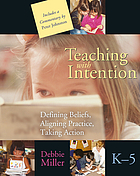Continuing to reflect on what I've learned from Debbie Miller's, Teaching with Intention book, she's got a section in there on lesson design.
 We've all experienced that moment where everything seems to be working so well, and chalk it up to luck. Which, it could be; a happy happenstance. But is there a way to be more intentional to work toward those positive, cohesive programs?
We've all experienced that moment where everything seems to be working so well, and chalk it up to luck. Which, it could be; a happy happenstance. But is there a way to be more intentional to work toward those positive, cohesive programs?Ms. Miller says there is. She uses a lesson design tool which asks her to consider the following questions for each lesson:
- What is the focus of the lesson? What do I want students to learn?
- Why is this important? How will it help students?
- How do I use this skill or strategy myself?
- What connections can I help students make?
- What books and/or materials will I need?
- Are there structures or formats that I need to show students how to do?
- How will I release responsibility to students during the lesson?
- Will students and I co-construct an anchor chart? What is its focus?
- What books and/or materials will students need?
- What do I want the students to do? Individually, and/or in pairs, and/or in small groups
- What will I do? confer, listen in, observe, meet with students in small groups
- What did you learn (content)? How will you teach us?
- What did you learn about yourself as a reader today that you didn't know before (process)? How will you teach us?
- What did I learn from my students during the workshop?
- Where do I/we need to go next with our learning?
So. We're not classroom teachers. We might see a group of kids for 60 minutes and never have that same combination of kids again. We almost always have wide age ranges of kids in our programs, which means that we might have some kids who can read, some who can't, some who have learning disabilities we don't know about, or who will need 59 minutes to feel safe and comfortable expressing their thoughts. Is it still possible to be intentional about our program design?
I think it is. Hopefully Ms. Miller doesn't mind me borrowing some of her ideas!
Here's my first attempt at drafting a document that I could imagine myself realistically using to plan programs, but also reflects intentionality. What do you think?


0 comments :
Post a Comment